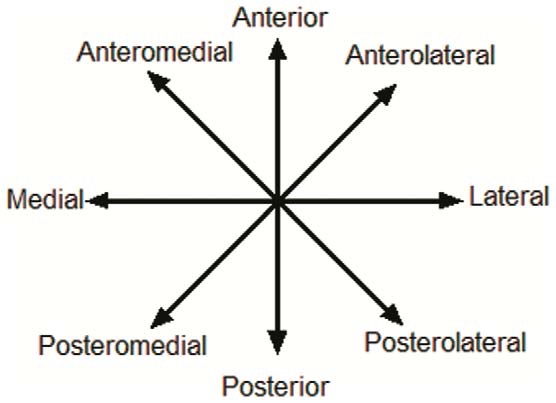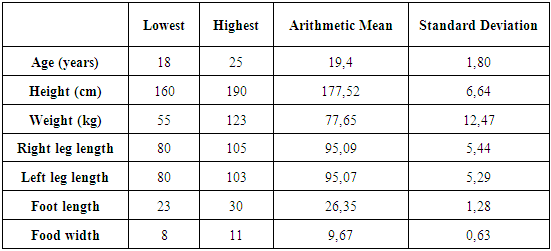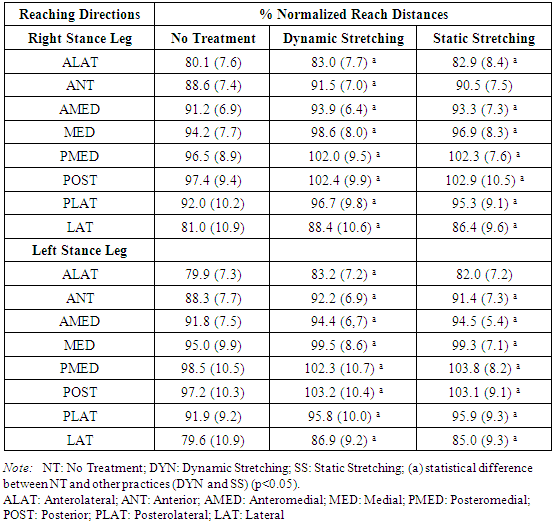-
Paper Information
- Next Paper
- Paper Submission
-
Journal Information
- About This Journal
- Editorial Board
- Current Issue
- Archive
- Author Guidelines
- Contact Us
International Journal of Sports Science
p-ISSN: 2169-8759 e-ISSN: 2169-8791
2017; 7(3): 99-104
doi:10.5923/j.sports.20170703.01

Acute Effects of Different Warm-up Methods on Dynamic Balance
Oya Erkut1, Ertuğrul Gelen2, Cengiz Sunar1
1Marmara University, Faculty of Sport Sciences, Istanbul, Turkey
2Sakarya University, Faculty of Sport Sciences, Sakarya, Turkey
Correspondence to: Oya Erkut, Marmara University, Faculty of Sport Sciences, Istanbul, Turkey.
| Email: |  |
Copyright © 2017 Scientific & Academic Publishing. All Rights Reserved.
This work is licensed under the Creative Commons Attribution International License (CC BY).
http://creativecommons.org/licenses/by/4.0/

Frequently used methods for warm-up are after-jogging static stretching performed at the aerobic intensity or loaded exercises applied in the dynamic style. Studies report that voluntary contractions to be performed from a mild level such as dynamic warm-up to high intensity before performing an athletic activity will increase power production and performance by activating the nerve-muscle function while static stretching decreases the relevant performance. Studies examining the effect of warm-up protocols on the balance performance in the literature are scarce. The aim of this study is to examine the acute effects of static and dynamic warm-up methods on balance performance. 3 different warm-up protocols were applied to fifty Physical Education and Sports students (21.5 ± 1.8 years, 177.7 ± 6.2 cm and 77.7 ± 5.4 kg) on non-consecutive days. Protocol A consisted of 5-minute low-intensity running and Protocol B consisted of static stretching exercises for the lower extremity following Protocol A (at intervals of 30 sec. and 10 sec. twice accompanied by pain). Protocol C was dynamic stretching (each exercise was repeated twice for 10 m. at increasing intensity after resting for 10 seconds) following Protocol A. The subjects performed the Star Excursion Balance Test after each warm-up protocol (Grible & Robinson, 2008). Protocols A, B, and C were compared with the variance analysis (ANOVA) and posthoc methods in repeated measurements. It was determined that there is a significant increase in all balance performances in Protocol B when compared to Protocol A (p<0,05). It can be said that both static stretching and dynamic stretching practices increase the balance performance. The most striking result of this study is that the expected negative effect of static stretching did not occur. Thus, warm-up methods that include static or dynamic stretching can be used before activities requiring dynamic balance in sports such as gymnastics.
Keywords: Dynamic Balance, Warm-Up, Static Stretching, Dynamic Exercise
Cite this paper: Oya Erkut, Ertuğrul Gelen, Cengiz Sunar, Acute Effects of Different Warm-up Methods on Dynamic Balance, International Journal of Sports Science, Vol. 7 No. 3, 2017, pp. 99-104. doi: 10.5923/j.sports.20170703.01.
1. Introduction
- Sports people do warm-up movements before starting to exercise, and these warm-up movements are followed by static and dynamic stretching movements after running at the aerobic intensity (Belm 2011; Davlin 2004; Gelen 2010). These warm-up movements increase the nerve conduction rate, enzyme cycle, muscle adaptation and body temperature by 1-2 degrees (Young & Belm 2002; Young 2007). Studies conducted in recent years report that static stretching (SS) and dynamic stretching (DS) have different effects on the sportive performance (Faigenbaum et al., 2005; McNeal, J and Sands W., 2003). It is claimed that static stretching has such benefits as preventing injuries in addition to increasing joint motion width, decreasing muscle fatigue and increasing performance (Hyrosomallis 2011). There are also research findings showing that it increases muscle fatigue (Young & Belm 2002; Young 2007). Static flexibility is considered as a method of increasing joint and muscle flexibility with neurologic and mechanic effects on MTU (Guissard & Duchateau, 2006). However, many studies carried out since the 2000s have also shown that static stretching exercises may affect performance negatively (Kokkonen et al. 1998; Belm et al. 2004, 2006; Gelen 2010). These studies show that SS decreases (1) the maximum power production of the muscle, (2) jumping height and (3) speed (Kokkonen 1998; Belm 2004; Gelen 2010). The negative effects on the performance are attributed to mechanical factors (changes in muscle stiffness and sensitivity of the reflexes) and neuromuscular factors such as MTU (decrease in motor neuron warning) (Guissard & Duchateau, 2006). In the literature, there are many studies on how and to what extent static stretching should be used in the warm-up exercises of sports branches requiring different performances, and some of these suggest not performing SS exercises for a long period in situations requiring the high level of performance (Costa et al., 2009; Chatzopoulos et al., 2014).Movements such as controlled jumping, bouncing, etc. performed in order to ensure the motion width of the joint are called dynamic stretching movements. Studies performed on the effects of dynamic stretching movements on the performance generally say that these exercises do not have positive or negative effects on the performance. However, they argue that dynamic stretching movements performed at different frequencies (100 beats/min, 50 beats/min) have different effects on jumping performance. It can be said that there is no difference between static stretching and dynamic stretching in the acute development of static stretching (Costa et al., 2009; Chatzopoulos et al., 2014). In a study, Behm (2004) expressed that dynamic stretching increases power production while Herda (2008) expressed that it does not increase muscle power. According to the literature, the most efficient warm-up should start with aerobic movements at the submaximal intensity, continue with wide dynamic stretching movements, and end with sports-specific dynamic activities to be performed. It is said that a static stretching movement should not be performed before activities such as power and high speed (Belm & Chaouachi 2011). Performance sports people may lose a contest or challenge due to a minor error of balance. For example, that a gymnast falls by failing to balance himself/herself after a somersault movement, or that a footballer loses his/her balance when he/she was about to score a goal. The ability of balance is not only important for the technical presentations of complex skills. The ability of balance, which is also quite important in terms of sportive performance, is necessary to maintain the balance stance and it is a complex motor skill, which is a basis for learning complex skills (Davlin C.D., 2004). The balance consists of two components, being static and dynamic. While static balance is the ability to keep the support base with the minimum movement, dynamic balance is regarded as the ability to regain balance on an uneven ground or after making a movement (Hyrosomallis, 2007; Hatziaki & Kioumourtzoglou 2002). Balance is affected by the visual, auditory and proprioceptive feedback (Gerbino, 2007). Proprioceptive information, which is known to have different contributions to balance, comes from the receptors in muscles, joints, and tendons (Hyrosomallis 2011; Belm, 2004, 2011; Pınar et al., 2010). Sudden changes in MTU (height, stiffness, power input and muscle activation) are the changes in the inputs of proprioceptive information and the output of muscle activation (Belm et al., 2004).Studies on the relationship between the balance skill and performance gradually increase. These studies have shown that the balance skill is quite important for athletic performance and a weak balance increases the risk of injury (Hyrosomallis, 2007). Many warm-up and stretching studies investigating the acute effects of dynamic and static stretching exercises on sports performance were conducted. Belm (2004) was to investigate acute bout of lover limb static stretching on balance, proprioception, reaction and movement time. They found that acute bout of static stretching impaired the warm-up effect achieved under control conditions with balance and reaction and movement time. However, as far as we know, the number of the studies comparing the acute effects of static and dynamic stretching movements on dynamic balance is quite low (Belm et al., 2004, Costa et al. 2009; Chatzopoulos et al., 2014; Handrakis et al., 2010; Daneshjoo et al., 2012).Hence, the aim of this study is to investigate the effects of different warm-up protocols on dynamic balance parameters, which include static and dynamic stretching movements, on the sports people. According to our hypothesis, different warm up protocol will affect dynamic balance differently. Moreover, we think that the warm-up protocol that includes static stretching exercises will negatively affect the balance performances of sports students.
2. Material and Method
- Experimental Approach to the ProblemA within subject, randomized, repeated- measures design was used to examine the acute effects of the WU methods on dynamic balance. For all WU protocols, participants began by jogging for 5 minutes at a target heart rate 140 beats per minute. Three different protocols were used in this study (Protocol A, B and C). Protocol A consisted of 5 min jogging in the sports hall till their heartbeat reached 140/ min. Protocol B consisted of 5 min jogging and static stretching of the lower extremities. Subjects performed each stretch slowly, deliberate manner with proper body alignment. Subjects held each stretch for 30 seconds at a point of mild discomfort, relaxed for 10 seconds. Protocol C consisted of 5 min jogging and dynamic exercises that progressed from moderate to high intensity. Subjects performed each exercise for a distance of 10 m, rested about 10 seconds, and then repeated the same exercise for 10 m as they returned to the starting point. After each warm-up protocol the athletes conducted the Star Excursion Balance tests (Gribble & Robinson, 2008). Balance test data obtained after each protocol were compared by repeated measures analyses of variance and post hoc comparisons. The independent variables (Protocol A, B and C) were to the determine different effect of warm-up protocol that was focused on dynamic balance on the left and right stance leg. The following dynamic balance parameters (left and right stance leg) were considered as dependent variables: Anterolateral; Anterior, Anteromedial, Medial, Posteromedial, Posterior, Posterolateral, Lateral (Figure 1).
 | Figure 1. Star Excursion Balance Test (SEBT) |
3. Results
- The arithmetic means and standard deviation values that define the average age, average length, right and left leg lengths, right and left foot lengths and width of 50 sportsmen included in our study are shown in Table 1.
|
|
4. Discussion
- Consequently, while there is a statistically significant difference between the control application and both the static and dynamic stretching practices for all parameters in our study (except for the right foot on the floor ANT and the left foot on the floor ALAT), no statistical difference was found in any parameter between dynamic stretching warm-up practice. According to the results of this study, it can be said that warm-up exercises that include dynamic and static stretching are not superior to one another to get prepared for the activities that require dynamic balance.Recently, many studies have been carried out in order to assess the effects of various warm-up methods on force, speed and especially flexibility. However, there is a limited number of studies carried out in order to investigate the effect of different warm-up methods on balance performance.Çoknaz et al. (2008) investigated the effect of different stretching periods in gymnasts on the performances of vertical jumping and flexibility. It was determined that a significant increase occurred in the flexibility of sports people when they performed stretching exercises * 10 times, each for 15 seconds (p<0.05). It was found out that there is no significant difference in the vertical jump tests between the first and last assessments (p>0.05). It was determined that static stretching exercises repeated for 10 times for 15 seconds each, and static stretching exercises repeated for 5 times for 30 seconds each have neither positive nor negative effect on the performance (Çoknaz et al., 2008). Gelen (2008) investigated the effect of different warm-up protocols on jumping. According to the findings of this study, it was found out that static stretching practices performed after low-intensity aerobic running negatively affect the vertical jumping height, while dynamic warm-up practices positively affect it (Gelen et al., 2008). In the study they conducted on adolescent sports people, Faigenbaum et al. (2005) investigated the acute effects of different warm-up protocols on anaerobic performances. They reported that dynamic warm-up and combined static stretching and dynamic warm-up practices positively affect the speed, health ball shootout and vertical jump performance (Faigenbaum et al. 2005). Daneshjoo et al. (2012) investigated the effects of different warm-up methods on proprioception, static and dynamic balance with 36 professional footballers below the age of 21 years. They reported that dynamic warm-up and combined static stretching and dynamic warm-up practices have positive effects on static and dynamic balance, but there is no statistically significant difference between them (Daneshjoo et al. 2012). Nejati (2015) investigated the effects of different warm-up methods on static balance and agility with 15 test subjects between the ages 18 and 30 years. Dynamic stretch and static stretching warm-up had a significant effect on agility and balance performance compared to no stretching. However, static stretching had no remarkable effect on balance in comparison to no stretching, but it did influence agility. Dynamic versus static warm-up group performed similarly statistically but based on the effect size analysis, the dynamic group had a larger effect size than static (Nejati et al 2015). In a study, Belm (2011) showed that flexibility workouts performed at the medium level can positively affect the static balance, reaction time (RT) and motion time (MT).Özkaptan (2006) carried out a study on 235 boys in total who attended the football summer school in order to determine the effect of different warm-up and stretching practices on 20 m speed performance and sit and reach flexibility. In this study, it was concluded that power production in children increases with dynamic warm-up practices at the medium-high intensity, and that the use of static stretching should be preferred in children during dynamic exercising practices and resting during warm-up due to the lack of persuasive evidence supporting the injury reducing and performance increasing potential of static stretching (Özkaptan, 2006).
5. Conclusions
- The results of the studies conducted on the effects of different warm-up protocols and different static stretching periods in recent years make the decisions of trainers and sports people harder. The question what type of flexibility exercises should be performed before the activity still draws attention as a subject that has not been investigated much. The results of this study can be an important indicator as stretching exercises are an important part of the warm-up and the balance feature is very important in certain specific branches (gymnastics, ice-skating, archery, etc.).
 Abstract
Abstract Reference
Reference Full-Text PDF
Full-Text PDF Full-text HTML
Full-text HTML
